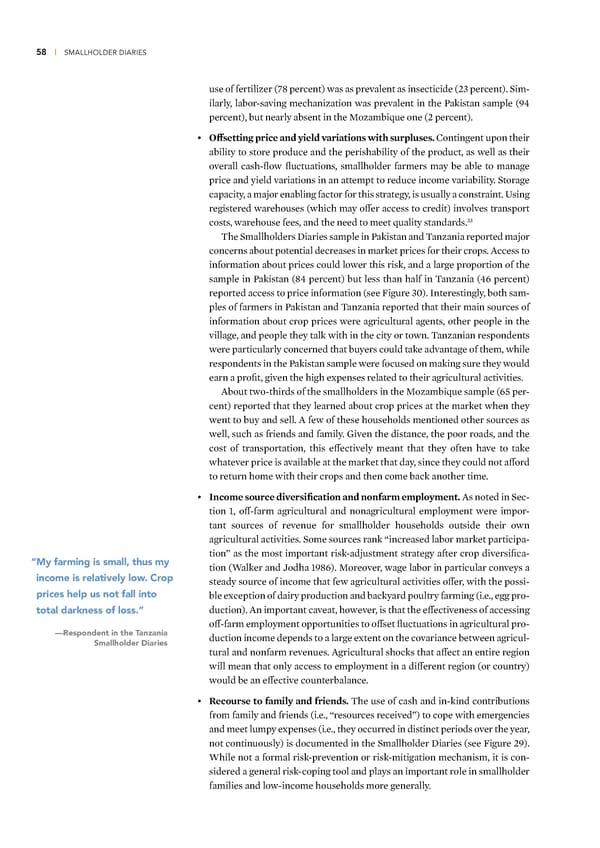58 | SMALLHOLDER DIARIES use of fertili—er (•¡ percent) was as prevalent as insecticide (‘Ÿ percent) Sim- ilarly, labor-saving mechani—ation was prevalent in the aistan sample (ž“ percent), but nearly absent in the –o—ambiue one (‘ percent) • –ffsetting price and yield ariations with surpluses †ontingent upon their ability to store produce and the perishability of the product, as well as their overall cash-flow fluctuations, smallholder farmers may be able to manage price and yield variations in an attempt to reduce income variability Storage capacity, a ma„or enabling factor for this strategy, is usually a constraint ©sing registered warehouses (which may offer access to credit) involves transport ŸŸ costs, warehouse fees, and the need to meet uality standards Œhe Smallholders ‰iaries sample in aistan and Œan—ania reported ma„or concerns about potential decreases in maret prices for their crops ˆccess to information about prices could lower this ris, and a large proportion of the sample in aistan (¡“ percent) but less than half in Œan—ania (“¢ percent) reported access to price information (see igure Ÿ’) €nterestingly, both sam- ples of farmers in aistan and Œan—ania reported that their main sources of information about crop prices were agricultural agents, other people in the village, and people they tal with in the city or town Œan—anian respondents were particularly concerned that buyers could tae advantage of them, while respondents in the aistan sample were focused on maing sure they would earn a profit, given the high expenses related to their agricultural activities ˆbout two-thirds of the smallholders in the –o—ambiue sample (¢” per- cent) reported that they learned about crop prices at the maret when they went to buy and sell ˆ few of these households mentioned other sources as well, such as friends and family ‡iven the distance, the poor roads, and the cost of transportation, this effectively meant that they often have to tae whatever price is available at the maret that day, since they could not afford to return home with their crops and then come bac another time • Šncome source diersification and nonfarm employment ˆs noted in Sec- tion …, off-farm agricultural and nonagricultural employment were impor- tant sources of revenue for smallholder households outside their own agricultural activities Some sources ran “increased labor maret participa- “ My farming is small, thus my tion” as the most important ris-ad„ustment strategy after crop diversifica- tion (™aler and Žodha …ž¡¢) –oreover, wage labor in particular conveys a income is relatively low. Crop steady source of income that few agricultural activities offer, with the possi- prices help us not fall into ble exception of dairy production and bacyard poultry farming (ie, egg pro- total darkness of loss.” duction) ˆn important caveat, however, is that the effectiveness of accessing off-farm employment opportunities to offset fluctuations in agricultural pro- —Respondent in the Tanzania duction income depends to a large extent on the covariance between agricul- Smallholder Diaries tural and nonfarm revenues ˆgricultural shocs that affect an entire region will mean that only access to employment in a different region (or country) would be an effective counterbalance • —ecourse to family and friends Œhe use of cash and in-ind contributions from family and friends (ie, “resources received”) to cope with emergencies and meet lumpy expenses (ie, they occurred in distinct periods over the year, not continuously) is documented in the Smallholder ‰iaries (see igure ‘ž) ™hile not a formal ris-prevention or ris-mitigation mechanism, it is con- sidered a general ris-coping tool and plays an important role in smallholder families and low-income households more generally
 Financial Diaries with Smallholder Families Page 73 Page 75
Financial Diaries with Smallholder Families Page 73 Page 75